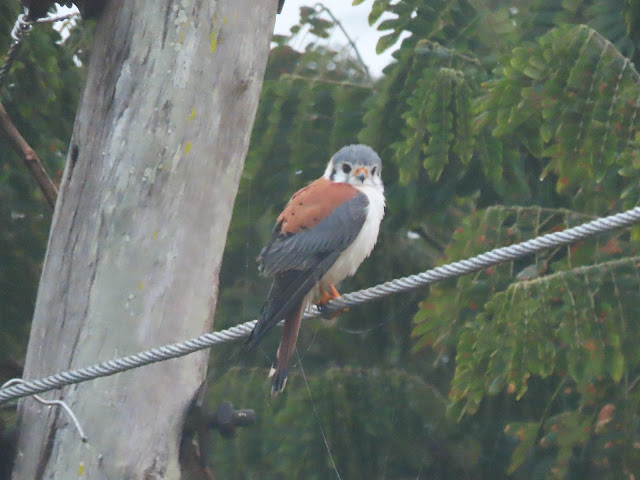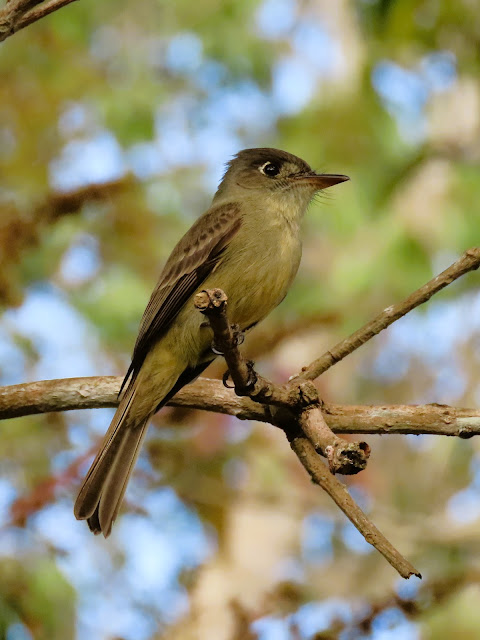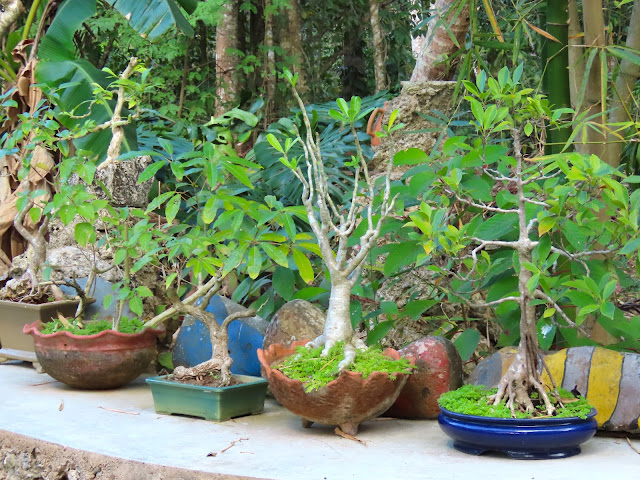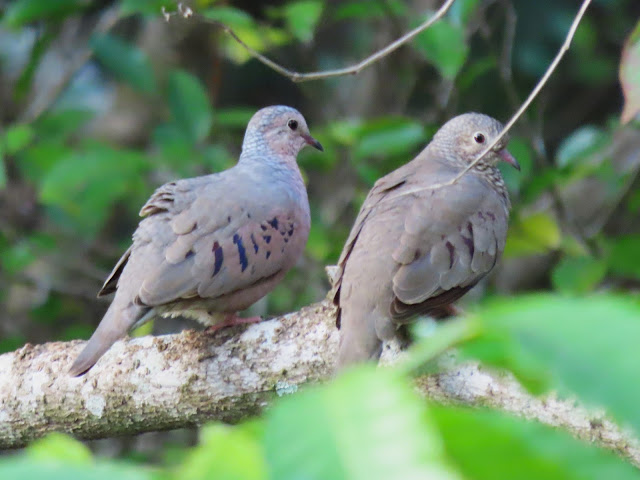12 February, 2023
Santo Tomás - Los Hondones - Canal de Los Hondones
Damita and Jose got up early to make coffee for us as we left at 05h:30 to head to the small community of Santo Tomás, whence we would embark on a journey deep into the swamp in a pole boat. It was a pleasure just to start the day with our congenial hosts. Jim and Barb were staying at the same casa as Miriam and me (and Tania) and we picked up the others en route.
Even before getting to the embarkation point, one of the distinct highlights of the entire trip occurred as far as I was concerned. Nightjars are never easy to see, but Tania worked her magic and we had two of them calling and in short order had fabulous views of them both resting on the road, and in the surrounding trees. I mean closeup, detailed, clear, gobsmacking views. It was nothing short of magical. My toes tingled for the rest of the day!
Unfortunately, we have no pictures to record the moment since all of this activity took place in total darkness. I will never forget the glow of the bird's eyes and their "short, evenly pitched, trilled whistle." At times they were right over our heads. Everyone was thrilled I know, but I was chatting with Victoria and she was as blown away as I was.
Days may start better; doubtless at times they do, but for us it couldn't have been any better than that February morning in Cuba.
Soon we arrived at our destination, being always in the safe, steady hands of Jiovani as he mastefully manoeuvered the vehicle along mandering, basic roads.
It was not quite light, and there was a shroud of mist hanging over the swamp and an American Kestrel (Falco sparverius) peered at us from the gloom.
Tania and Tina strode along with them, accompanied by the obligatory guide in this part of the national park. That poor guy didn't really have a chance to leave an impression on any of us!
There were several types of fern, as one might expect in this moist habitat. They are difficult enough to identify at home, let alone in Cuba, so other than saying with confidence that they are in the order Podypodiales I can offer no further clue as to their identification!
I was lucky enough to share a boat with Lisa and Tina, the enthusiastic and ever upbeat, appropriately-named Den Besten sisters.
We had meandered only a short distance along the channel when Tania heard a Zapata Sparrow (Torreornis inexpectata) and in mere minutes it popped into view.
It is a very special moment for a birder to first encounter an endemic species, but I am confident that even non-birders would appreciate the unique satisfaction of seeing an organism that appears nowhere else on the planet. Even in Cuba, it is found only in the Zapata Swamp.
I am not sure whether the gastropod eggs shown below belong to Apple Snails (Ampullariidae), but it is quite possible.
As you know from my previous post, Snail Kite (Rostrhamus sociabilis) occurs in Cuba, and they are specialist feeders on apple snails.
Are these empty shells left after a bout of feeding?
I claim no expertise at even the minutest level with gastropods, so if anyone can confirm or refute this conjecture, feel free to comment below.
I think that the lizard in the next picture is a species of dwarf gecko (Sphaerodactylidae) but the specific identification eludes me.
Whitetop Sedge (Rhynchospora colorata) dotted the banks of the channels and rivulets throughout the swamp.
The channels were inviting, not yielding their secrets easily, but willing to surrender them to the diligent explorer.
We had a brief, but clear view of Zapata Wren (Ferminia cerverai); unfortunately no one was able to get a picture of it.
Look carefully in the picture below and you will see a Cuban Parakeet (Psittacara euops) giving a text book illustration of camouflage.
Turkey Vultures (Cathartes aura) are usually seen soaring effortlessly in the sky, so it was interesting to observe this individual at close range.
After our idyllic meander through the waterways we returned to Jiovani and our vehicle to have breakfast.
There were several goats in the area, but they behaved with commendable restraint and never tried to snatch a sandwich from anyone.
With full stomachs, we entered a trail to search for the rare, regionally endemic Grey-headed Quail-Dove (Geotrygon caniceps).
After a lengthy search we had glimpses of it, far off and camouflaged against the substrate. Not the most satisfactory experience of a "lifer" for everyone, but it would have to do.
A great look at a Cuban Trogon (Priotelus temnurus) was much more satisfying.
It's always good to glance at the ground. This insect looks very interesting, but I have been unable to identify it unfortunately.
When it was time for lunch we went to a lovely little restaurant on the Bay of Pigs, site of a misplaced invasion of a tiny nation by a world superpower, ill-conceived in planning and implementation, and a proud legacy for Cuban patriots.
Lunch was a fine affair. I had fish soup, red snapper filets, rice, squash, salad, and coconut pudding and coffee. The waiter was friendly, the sun shone, we had Tania to take care of us, and the world was indeed a fine place.
We all returned to our respective casas for siesta time.
Jim had trouble with his suitcase and knowing the ingenuity of Cubans for fixing anything, including vintage cars that would command a tidy sum in Canada from antique car enthusiasts, he inquired whether help to repair it might be an option.
Jim decided he would assume a supervisory role only and sipped contently on his coffee.
We left to go to Tania's house to watch birds in her backyard, with the guys working diligently on the suitcase. When we returned it was fixed - as Jim said, "Better than ever!"
Just before going through Tania's gate we spotted
a LaSagra's Flycatcher.
Here we are going in, although it looks as though we are going out. We were evidently glancing back at something.
A Cape May Warbler (Setophaga tigrina) is an elusive species in Ontario; in Cuba it is a backyard bird!
Yellow-faced Grassquit (Tiaris olivaceus) is both ubiquitous and delightful, and seemed to favour this feeder made from a split stalk of bamboo, filled with rice.
Black-throated Blue Warbler (Setophaga caerulescens) will soon be responding to its Zugunruhe and will be leaving for breeding grounds in northern North America.
West Indian Woodpecker (Melanerpes superciliaris) was very fond of coconut, returning to it over and over again.
Just imagine how delighted you would be if Ovenbird (Seiurus aurocapilla) was a regular in your backyard.
Selwyn's favourite, Cuban Emerald (Riccordia ricordii) - Zunzún to the cognoscenti, was frequently seen.
Not nearly as showy as the warblers and woodpeckers, a pair of Common Ground Doves (Columbina passerina) was no less pleasing.
Blue-headed Quail-Dove (Starnoenas cyanocephala) is a very handsome Cuban endemic, and Tania has a pair coming to her own backyard!
Here you see the size comparison between the two columbids.
We were a very happy group of birders, sitting in an enchanted garden, sipping coconut water from freshly topped shells, with visions of tropical wonder all around us.
Even the wall was interesting and no doubt harboured many arthropods and other tiny creatures. Small lizards patrolled the crannies in search of invertebrate prey.
A couple of local children rushed out to see Tania, and Barb kindly removed a couple of Canada flag pins from her clothing to donate to them.
I think this flower is Bidens odorata (ok, no jokes about the US President!), but I am not a hundred percent confident of my ID.
Tania has seen this species here before but we were unable to locate it. We returned later, however, when it was almost dark, and to Victoria went the honour of finding it. It was a brief look, masked by the gloom, but our target species, nevertheless.
Our final stop of the day was at the Hondones Canal.
We were joined by an Anhinga (Anhinga anhinga) and a Great Blue Heron (Ardea herodias) as the sun slowly set on a perfect day.











































































































...David, you saw some beautiful sights, but for me the boats didn't look attractive. I'd want both of my feet on the ground.
ReplyDeleteBefore COVID were you not in the habit of flying to Hawaii?
DeleteWhat a marvelous trip. Sounds like everything went smoothly and the birds knew when to show up!
ReplyDeleteGreat photos, David. The birds are very beautiful. The hole trip looks like a big adventure. I'm sure you enjoyed every minute of it!
ReplyDeleteThe plant with orange leaves looks like a coleus, but I'm not 100% sure.
Hugs and kisses, Marit
These are beautiful shots.
ReplyDeleteSo many wonderful pictures! Thank you for sharing. It's hard to pick a favorite but I think it might be the Blue-headed Quail-Dove.
ReplyDeleteLook how fresh and happy we looked at the end of a very long day. Ready for more action but sadly the day was too short !
ReplyDeleteWe packed a lot into every day, didn't we?
DeleteSo many interesting birds and other species I would never see in North Dakota--lol! :)
ReplyDeleteAn experience truly of paradise. Enjoyed all the wonderful photos.
ReplyDeleteHari OM
ReplyDeleteJust glorious, every bit of it... YAM xx
hello David
ReplyDeleteYou approach a trip like this with a lot of preparation and have your own expectations of what is going to happen in front of the lens, then your expectations will be exceeded by a lot, plus a group of good friends who couldn't be better, this trip will always please you to be remembered, thank you very much for the report and for the beautiful pictures.
Greetings Frank
A trip to cherish. You saw so much in beautiful surroundings.
ReplyDeleteJaki piękny i treściwy reportaż! Dziękuję Ci za tą opowieść i ciekawe zdjęcia. Mogę przeżywać tą podróż z Wami. Ptaki jak z bajki!
ReplyDeleteHello David,
ReplyDeleteMangroves or swamps are a source of richness for the fauna and its observer, I am very happy in them.
I already know that when I see some of the birds here, I will find them again in Yucatan next year :-)
The Torgon is a wonder.
Good day my friend
Take great care in the Yucatan, Nathalie. Mexico is a dangerous place these days.
DeleteWhat a great experience this trip with other birdwatchers seems to me.
ReplyDeleteI enjoyed all the photos.
Greetings Irma
Well that was incredibly enjoyable and took my whole breakfast period (so I'll have to do Wordle later). The Yellow-faced Grassquit has won my 'memorable unusual name' prize although as I'm largely aphantasic not my 'memorable picture' prize.
ReplyDeleteWe do Wordle after lunch, Graham.
DeleteThis would be my favorite day! Being in a boat all day, seeing all sorts of beautiful things. Then time at Tania's home, which is lovely and what a venue. That sunset is fabulous. I'm sorry darkness prohibited a photograph. Alas, it remains a photograph of the heart.
ReplyDeleteWhat a wonderful ay you had. I can imagine your joy at seeing so many unique and new-to-you birds. What an adventure you had! Hugs,Valerie xxxx
ReplyDeleteWow, beautiful images, all of them.
ReplyDeleteFoggy mornings have charm.
ReplyDeleteYour Zapata Swamp adventure is one that I would love to have participated in, David. And as far as Tania's back garden is concerned, it has to be one of the most fabulous gardens on the planet! I sometimes have difficulty in tearing myself away from my own back garden but, if I had Tania's garden and its visitors, I wouldn't stand a chance. I'd be home-bound.
ReplyDeleteI'm now looking forward to Pt.4
My very best wishes to you and Miriam - - - Richard
It was quite incredible, Richard.
DeleteWhat a wonderful day. You certainly managed to pack in some incredible sightings!
ReplyDeleteHello David :=)
ReplyDeleteYour posts are always a pleasure, your Snowy Owls, Nuthatches and Canada Geese to name a few are beautiful species, which I thoroughly enjoy seeing and now this Cuban Holiday has definitely been a thrilling experience with exotic looking birds everywhere. The Great Lizard Cuckoo stands out as an astounding bird, in it's likeness to a lizard in the first image, and in the second it's fluffed up plumage and its unusual appearance is not likely to be forgotten by me. The Cuban Grassquit and the Cuban Trogan to just name a few birds are very beautiful. Tanias garden is fabulous, and you all look in your element enjoying the views and sightings. The boat trip, and tropical vegetation and that gorgeous sunset, Wow what a day to remember. :=)
Hugs and my best wishes David and have a safe journey.
What an amazing trip!
ReplyDeleteSo many wonderful photos to enjoy, David!
Hi David - all I can do is copy your own comment: Life is always good; sometimes it's perfect! ... that looks like quite the most wonderful day ... yes not even trip. Brilliant - cheers Hilary
ReplyDeleteOtra buena caminata, en la que has capturado, buenos lugares y bellas imágenes.
ReplyDeleteFeliz fin de semana.
Dear David, I can understand your excitement about the nightjars; there is simply no substitute for such special, magical experiences. Oh yes, seeing an endemic species like the Zapata Sparrow would give me satisfaction too - always assuming I knew what I was looking at. As for the gastropods - Google lens agrees with you that they are apple snails. I would be interested: what tools do you use to identify animals and plants? As far as your presumed dwarf gecko (Sphaerodactylidae) is concerned, Google lens is of the firm opinion for both photos that the animal belongs to the genus Anoles, also known as band lizards - but without a more precise determination. (You also identified an anole below. Wikipedia says: Anoles is the most species-rich genus of lizards, with 444 recognized species.)
ReplyDeleteThe Cuban Parakeet really camouflaged itself masterfully - we also had several such "camouflaged sightings" in Costa Rica. Fascinating, but also a bit "photographically frustrating". But apart from that, you only had reasons to be happy! How wonderful that you saw so much beauty and were a happy group of bird watchers! That's the Cuba-Version of Pura Vida ❤️ ...
Thank you for your great travelogues - see you next time!
Hugs, Traude
https://rostrose.blogspot.com/2023/03/streifzug-durch-die-letzten-wochen.html
Hi Traude: I always use peer-reviewed journals or textbooks, very rarely the internet.
DeleteAll I can say is WOW! What a great trip. Thanks for sharing it with us.
ReplyDeleteUn tercer capítulo precioso. Un buen viaje y muy aprovechado a Cuba, realmente tiene mucho que ver y sobre todo muy buenas observaciones de aves. Gran patrimonio que ojalá lo protejan y cuiden como se merece.
ReplyDeleteUn gran abrazo amigo mío y compadre y gracias por compartir tanta belleza, feliz fin de semana.
Information I didn't know about zapata sparrow and other birds that are typical of Cuba island. Thanks for sharing your interesting report!
ReplyDeleteThe variety and beauty of the birds that you have been able to enjoy, in the different habitats that you visited in this third installment of your ornithological trip to Cuba is simply spectacular. A big hug David
ReplyDeleteWhat a lot of amazing adventures you had here. All those amazing birds. Wow.
ReplyDeleteThat was an incredible, joyful trip.
ReplyDeleteWow, you saw some amazing birds David. What was that rare one you could only get glimpses of? I think it's great how there are lots of what you might see at home in the summer and those you wouldn't. It looks like a birding paradise. And I was happy to see the guanabana fruit as I had the most delicious shake (guanabana and leche) made with that in Costa Rica. It was some of the most memorable tastes from my trip even though it was 10 years ago. hugs-Erika
ReplyDeleteSo many familiar birds seen in cuba as we have in Texas. Yet, some are exotic and oh so beautiful!! I'd like to try that fruit!!
ReplyDeleteThanks for linking up.
~Anni @ I'd Rather B Birdin'.
Hello David, wow what a place, what abundance of birds, what wonderful people to have enjoyed all this beauty with. Overwelming!!!
ReplyDeleteWarm regards,
Roos
Encantada de ver la tercera parte del viaje. Me alegra mucho que lo pasaran tan bien, yo también habría estado feliz. Abrazos.
ReplyDeleteHello David,
ReplyDeleteI've just spent some time this evening enjoying your three posts about Birding in Cuba. What a wonderful assortment of birds you saw. I read a book some years ago (and re-read it often - Frenchman's Creek by Daphne du Maurier) in which the Nightjar is mentioned numerous times. How wonderful that you were able to see one.
Kind people, comfortable housing, good food, and all those birds and flowers add up to a wonderful trip! Thank you for sharing it with us.
what a fabulous day! and such a beautiful place with all the different birds.
ReplyDeleteSo many wonderful photographs.
ReplyDeleteA lovely trip.
All the best Jan
Your bird photos are wonderful, and I enjoyed learning about many new-to-me bird species.
ReplyDeletebest… mae at maefood.blogspot.com
Zugunruhe? How did this German word make it into your blog? It's perfectly clear what it means, is this a standard expression for birders?
ReplyDeleteI have never been in a swamp and I would love to experience this. This is completely mesmerizing for me.
The Cuban parakeet is very well camouflaged indeed. Even after I had seen the close-ups, it still took me a bit to find it in the first of the three photos.
You really packed a lot into this one day, and how rewarding it must have been. Tania's garden is a true gem, what a magnificent little paradise.
Zugunruhe was coined by a German ornithologist to describe the condition known in English as Migratory Restlessness. I like the German expression much better and it is in fairly common usage among ornithologists studying or reporting on migration.
DeleteWow, great day, beautiful landscape and Tania's garden is fantastic. Overwelming so many stunning brids!
ReplyDeleteGreetings, Maria
What a spectacular array of birds! Most were birds I'd never seen before. Just marvelous!
ReplyDelete